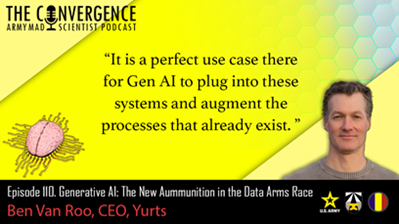“It is a perfect use case there for Gen AI to plug into these systems and augment the processes that already exist.”
[Editor’s Note: Today’s The Convergence podcast welcomes back Ben Van Roo, recent author of our Unlocking TRADOC’s Potential with GenAI: Opportunities and Challenges blog post, to continue our exploration of the transformative potential of Generative Artificial Intelligence (Gen AI) — specifically its ability to democratize access across the U.S. Army to the vast reservoirs of Operational Environment information. In ingesting all of the OE Data Integration Network’s (ODIN) content — including the Worldwide Equipment Guide (WEG), Decisive Action Training Environment (DATE) and accompanying Force Structures, the Army Techniques Publication (ATP) 7-100 series, and the Training Circular (TC) 7-100 series — Gen AI offers the potential to respond to conversational queries from individual Soldiers with the TRADOC G-2’s aggregated and authoritative OE knowledge. Operationally, Gen AI could also help accelerate the OODA (Observe, Orient, Decide, and Act) loop, the intelligence cycle, and even kill chains — powerful stuff, indeed…. Read on!]
[If the podcast dashboard is not rendering correctly for you, please click here to listen to the podcast.]
 Ben Van Roo is the Co-Founder and CEO of Yurts, a generative AI company partnering with the U.S. Department of Defense to advance mission-critical systems. He holds a PhD in Operations Research and has significant experience developing AI solutions for defense and national security applications.
Ben Van Roo is the Co-Founder and CEO of Yurts, a generative AI company partnering with the U.S. Department of Defense to advance mission-critical systems. He holds a PhD in Operations Research and has significant experience developing AI solutions for defense and national security applications.
In our latest episode of The Convergence podcast, Army Mad Scientist sits down with Ben Van Roo to discuss Generative Artificial Intelligence (Gen AI) models, how they can be integrated into secure networks, and how TRADOC can use them to enhance Army training. The following bullet points highlight key insights from our conversation.
-
-
- Classic AI models could provide rudimentary identification abilities,
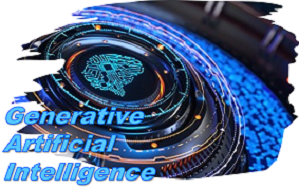 whereas Gen AI is a newer class of models with the capability to produce long form documents, generate and critique ideas, and create new images, video, and music.
whereas Gen AI is a newer class of models with the capability to produce long form documents, generate and critique ideas, and create new images, video, and music.
- Classic AI models could provide rudimentary identification abilities,
-
-
-
- The technology enabling Gen AI is moving at a rapid pace. As soon as a new model is available, competitors and adversaries will use that newer model to upgrade their own, fostering a rapid learning and adaptation cycle. When thinking about the geopolitical implications and
 competition, there is a very tight timeline of advantage between open-source communities, proprietary model vendors, and the U.S. and other countries.
competition, there is a very tight timeline of advantage between open-source communities, proprietary model vendors, and the U.S. and other countries.
- The technology enabling Gen AI is moving at a rapid pace. As soon as a new model is available, competitors and adversaries will use that newer model to upgrade their own, fostering a rapid learning and adaptation cycle. When thinking about the geopolitical implications and
-
-
-
- Where Gen AI is useful today is plugging into pre-existing systems and augmenting the processes that already exist. TRADOC’s mission of preparing the Warfighter in basic aspects of readiness, for different
 environments (e.g., Decisive Action Training Environment [DATE]), understanding our adversaries’ materiel capabilities in the Worldwide Equipment Guide, and much more is a perfect use case for employing the current state of Gen AI technology.
environments (e.g., Decisive Action Training Environment [DATE]), understanding our adversaries’ materiel capabilities in the Worldwide Equipment Guide, and much more is a perfect use case for employing the current state of Gen AI technology.
- Where Gen AI is useful today is plugging into pre-existing systems and augmenting the processes that already exist. TRADOC’s mission of preparing the Warfighter in basic aspects of readiness, for different
-
-
-
- While DoD is experimenting with Gen AI in aspects such as computer vision or Course of Action development, it is more suited to bridge the
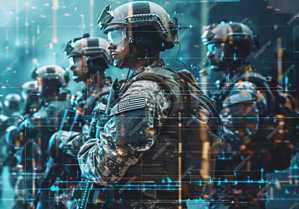 gap between the technology vendors and the Warfighters. The Government lacks what a large venture-backed company with a sole focus on writing Gen AI software can provide.
gap between the technology vendors and the Warfighters. The Government lacks what a large venture-backed company with a sole focus on writing Gen AI software can provide.
- While DoD is experimenting with Gen AI in aspects such as computer vision or Course of Action development, it is more suited to bridge the
-
-
-
- For large organizations like the DoD, within the next 2 to 3 years, the fundamental focus will be on how to bring Gen AI into production —
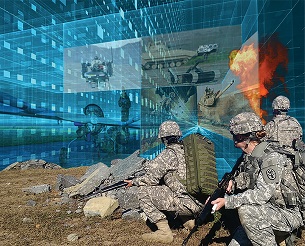 how it’s integrated, where it shouldn’t be, and how management, costs, and analytics will be conducted. In the commercial technology space, generative AI technology will be ubiquitous in 7-10 years.
how it’s integrated, where it shouldn’t be, and how management, costs, and analytics will be conducted. In the commercial technology space, generative AI technology will be ubiquitous in 7-10 years.
- For large organizations like the DoD, within the next 2 to 3 years, the fundamental focus will be on how to bring Gen AI into production —
-
-
-
- Using Gen AI, the Army has the potential opportunity to rapidly learn and understand the conditions of an evolving Operational Environment by querying a digital subject matter expert – e.g., the
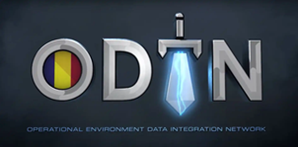 TRADOC G-2’s OE Data Integration Network (ODIN) authoritative digital resource — to access and process TRADOC’s corpus of relevant Army Techniques Publications (ATPs) and training circulars (7-100 series), insights, and intelligence reports – via plain language queries.
TRADOC G-2’s OE Data Integration Network (ODIN) authoritative digital resource — to access and process TRADOC’s corpus of relevant Army Techniques Publications (ATPs) and training circulars (7-100 series), insights, and intelligence reports – via plain language queries.
- Using Gen AI, the Army has the potential opportunity to rapidly learn and understand the conditions of an evolving Operational Environment by querying a digital subject matter expert – e.g., the
-
-
-
- In an operational setting,
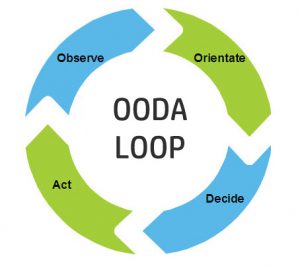 Gen AI could help accelerate the pace of our OODA loop (Observe, Orient, Decide, and Act), shortening the cycles between Observation and taking Action – affecting everything from the intelligence cycle to the kill chain itself.
Gen AI could help accelerate the pace of our OODA loop (Observe, Orient, Decide, and Act), shortening the cycles between Observation and taking Action – affecting everything from the intelligence cycle to the kill chain itself.
- In an operational setting,
-
If you enjoyed this post, check out Ben Van Roo‘s previous Mad Scientist Laboratory post — Unlocking TRADOC’s Potential with GenAI: Opportunities and Challenges
Read TRADOC Pamphlet 525-92, The Operational Environment 2024-2034: Large-Scale Combat Operations
Explore the TRADOC G-2‘s Operational Environment Enterprise web page, brimming with authoritative information on the Operational Environment and how our adversaries fight, including:
Our China Landing Zone, full of information regarding our pacing challenge, including ATP 7-100.3, Chinese Tactics, BiteSize China weekly topics, People’s Liberation Army Ground Forces Quick Reference Guide, and our thirty-plus snapshots captured to date addressing what China is learning about the Operational Environment from Russia’s war against Ukraine (note that a DoD Common Access Card [CAC] is required to access this last link).
Our Russia Landing Zone, including the BiteSize Russia weekly topics. If you have a CAC, you’ll be especially interested in reviewing our weekly RUS-UKR Conflict Running Estimates and associated Narratives, capturing what we learned about the contemporary Russian way of war in Ukraine over the past two years and the ramifications for U.S. Army modernization across DOTMLPF-P.
Our Iran Landing Zone, including the latest Iran OE Watch articles, as well as the Iran Quick Reference Guide and the Iran Passive Defense Manual (both require a CAC to access).
Our Running Estimates SharePoint site (also requires a CAC to access), containing our monthly OE Running Estimates, associated Narratives, and the 2QFY24, 3QFY24, 4QFY24, and 1QFY25 OE Assessment TRADOC Intelligence Posts (TIPs).
Then review the following related Mad Scientist Laboratory content exploring the transformative power of AI — spanning the gamut of potential applications:
Artificial Intelligence (AI) Trends
Takeaways Learned about the Future of the AI Battlefield and associated information paper
Artificial Intelligence: An Emerging Game-changer
Artificial Intelligence: Shaping the Future of Biological-Chemical Warfare, by Jared Kite
Training Transformed: AI and the Future Soldier, by proclaimed Mad Scientist SGM Kyle J. Kramer
The AI Study Buddy at the Army War College (Part 1) and associated podcast, with LtCol Joe Buffamante, USMC
Hybrid Intelligence: Sustaining Adversary Overmatch and associated podcast, with proclaimed Mad Scientist Dr. Billy Barry and LTC Blair Wilcox
Rise of Artificial Intelligence: Implications to the Fielded Force, by John W. Mabes III
Integrating Artificial Intelligence into Military Operations, by Dr. James Mancillas
“Own the Night” and the associated Modern War Institute podcast, with proclaimed Mad Scientist Bob Work
Bringing AI to the Joint Force and associated podcast, with Jacqueline Tame, Alka Patel, and Dr. Jane Pinelis
Thoughts on AI and Ethics… from the Chaplain Corps
The AI Study Buddy at the Army War College (Part 2) and associated podcast, with Dr. Billy Barry, USAWC
Gen Z is Likely to Build Trusting Relationships with AI, by COL Derek Baird
Hey, ChatGPT, Help Me Win this Contract! and associated podcast, with LTC Robert Solano
Chatty Cathy, Open the Pod Bay Doors: An Interview with ChatGPT and associated podcast
The Future of Learning: Personalized, Continuous, and Accelerated
The Guy Behind the Guy: AI as the Indispensable Marshal, by Brady Moore and Chris Sauceda
AI Enhancing EI in War, by MAJ Vincent Dueñas
The Human Targeting Solution: An AI Story, by CW3 Jesse R. Crifasi
An Appropriate Level of Trust…
Disclaimer: The views expressed in this blog post do not necessarily reflect those of the U.S. Department of Defense, Department of the Army, Army Futures Command (AFC), or Training and Doctrine Command (TRADOC).

